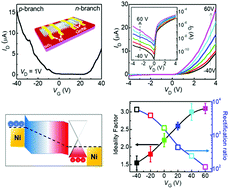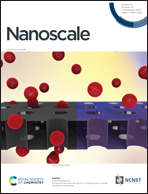High performance complementary WS2 devices with hybrid Gr/Ni contacts†
Abstract
Two-dimensional (2D) transition metal dichalcogenides have attracted vibrant interest for future solid-state device applications due to their unique properties. However, it is challenging to realize 2D material based high performance complementary devices due to the stubborn Fermi level pinning effect and the lack of facile doping techniques. In this paper, we reported a hybrid Gr/Ni contact to WS2, which can switch carrier types from n-type to p-type in WS2. The unorthodox polarity transition is attributed to the natural p-doping of graphene with Ni adsorption and the alleviation of Fermi level pinning in WS2. Furthermore, we realized asymmetric Ni and Gr/Ni hybrid contacts to a multilayer WS2 device, and we observed synergistic p–n diode characteristics with excellent current rectification exceeding 104, and a near unity ideality factor of 1.1 (1.6) at a temperature of 4.5 K (300 K). Lastly, our WS2 p–n device exhibits high performance photovoltaic ability with a maximum photoresponsivity of 4 × 104 A W−1 at 532 nm wavelength, that is 108 times higher than that of graphene and 50 times better than that of the monolayer MoS2 photodetector. This doping-free carrier type modulation technique will pave the way to realize high performance complementary electronics and optoelectronic devices based on 2D materials.



 Please wait while we load your content...
Please wait while we load your content...